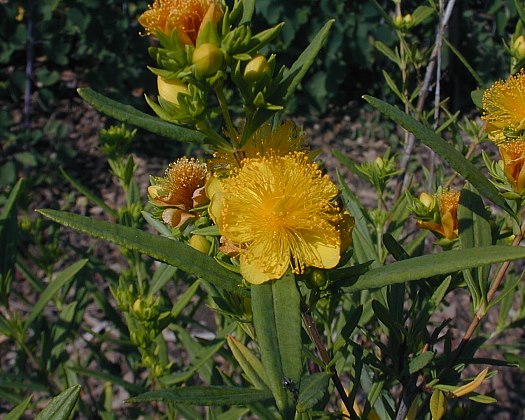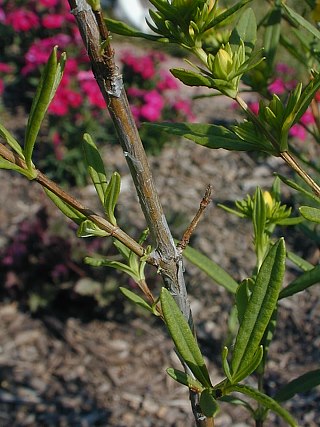Description: This shrubby perennial wildflower is abundantly branched and 2-4' tall. The lower stems are woody with shredded gray-brown bark, while the upper stems are green and slightly winged on opposite sides. The opposite leaves are up to 3" and ¾" across (usually about one-half this size); they are linear-oblong to oblong-elliptic in shape, smooth along their margins, and hairless. The upper surfaces of the leaves are medium green, while their lower surfaces are pale green; they are sessile or taper to short petioles. The upper stems terminates in small clusters of 3-7 flowers; additional clusters of flowers may appear along the 2 upper pairs of opposite leaves. Each flower is ¾–1" across, consisting of 5 yellow petals, 5 green sepals, a pistil with 3 united styles, and abundant stamens. The petals are much larger than the sepals.

The blooming
period occurs during the summer and lasts about 2 months. Each flower
is replaced by an ovoid-lanceoloid seed capsule about 1/3–1/2" (8-12
mm.) in
length. At the apex of each seed capsule, the tips of the 3 styles
persist and become separated. Each seed capsule is divided into 3 cells
and divides into 3 parts at maturity to release the seeds. The small
seeds are narrowly oblongoid, flattened, and black. The root system is
woody and branching.
Cultivation:
The preference is full or partial sun, moist to dry-mesic conditions,
and somewhat barren rocky ground. This shrubby wildflower is readily
cultivated in gardens.
Range & Habitat:
The native Shrubby St. John's Wort is occasional in the southern half
of Illinois
and largely absent in the northern half of the state (see Distribution
Map). Habitats include upland prairies, upland rocky
woodlands and bluffs, rocky stream banks, edges of swamps, abandoned
fields, pastures, and roadside embankments. Some local populations near
urban areas may be escaped
cultivated plants.
areas may be escaped
cultivated plants.
Faunal Associations:
The flowers are cross-pollinated primarily by bumblebees, which collect
pollen for their larvae. Other insect visitors that seek pollen from
the flowers include Syrphid flies and Halictid bees, but they are less
effective at cross-pollination. Sometimes butterflies and wasps land on
the flowers, but they are vainly seeking nectar -- the flowers offer
only pollen from the abundant stamens as a floral reward. Insects that
feed destructively on Shrubby St. John's Wort and other Hypericum spp.
include the aphid Aphis hyperici and other aphids, the leafhoppers Erasmoneura margaritae and Erasmoneura rubricata, Paria sellata and other
leaf beetles, caterpillars of the butterfly Strymon
melinus (Gray Hairstreak), caterpillars of Nedra ramosula (Gray Half-spot) and other moths, and Clastoptera hyperici (St. John's Wort Spittlebug). The Insect
Table lists these species and many others. Most mammalian herbivores
avoid consumption of Hypericum spp. because their
foliage contains varying amounts of the phototoxic chemical, hypericin.
In the presence of light, this chemical can cause rashes to develop on
light-skinned animals and it can irritate the gastrointestinal tract.
Photographic Location:
A flower garden at the Arboretum of the University of Illinois in
Urbana, Illinois.
Comments: Shrubby St. John's Wort has attractive flowers and foliage. It differs from many other Hypericum spp. by its woody lower stems. It is easy to confuse this species with the woody Hypericum kalmianum (Kalm's St. John's Wort), which is restricted to sandy areas near the Great Lakes (including Lake Michigan in NE Illinois). This latter species has 5-celled seed capsules with 5 style-tips, while Shrubby St. John's Wort has 3-celled seed capsules with 3 style-tips. There are also species of St. John's Wort that have 1-celled seed capsules with singular style-tips; some of these may be slightly woody at the base. A widely cultivated woody species, Hypericum frondosum (Golden St. John' Wort), has larger flowers (greater than 1" across) and wider leaves (greater than ¾" across) than Shrubby St. John's Wort. Golden St. John's Wort is native to the southeastern states, but not Illinois. Another scientific name of Shrubby St. John's Wort is Hypericum spathulatum.